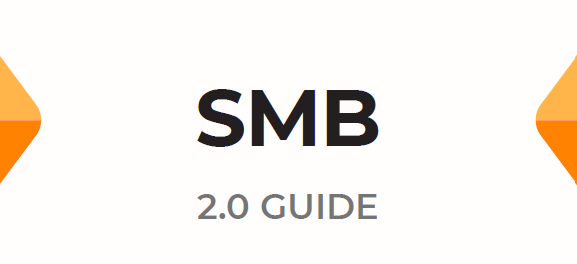Download the complete guide here.
This 2.0 Guide is intended to show the state of small and midsize business (SMB) services available to credit unions. It should also offer some perspective about why supporting SMBs is critical to credit union and community growth.
More and more credit unions are ramping up their SMB (small and midsize business) services—or at least they claim to be. If your credit union’s SMB services are limited to a business checking account that doesn’t look much different from a personal checking account and has no business-specific digital services, you’re falling behind.
Today, running a business—from a one-person operation to a company with hundreds of employees—is more complex than ever before. That means the financial services needs of those businesses are more complex than ever before. With their community focus, this creates an ideal opportunity for credit unions that provide the services these businesses actually need.
This guide seeks to explore SMB opportunities and examine the ways that credit unions and their competitors are capitalizing on these opportunities.
Download this and other guides here.
SMB Trends and Statistics
The following trends and statistics paint a picture about why credit unions can (and should) use business banking as a growth strategy.
Trend 1: As BNPL (buy now pay later) companies falter, consumer demand continues to grow.
Pureplay BNPL companies are struggling. Take Klarna, for example. That company’s losses more than tripled for the first half of 2022. Over at Affirm, that company’s stock price dropped 93% between Nov. 2021 and June 2022. The days of the pureplay BNPL provider may very well be numbered.
Yet consumer demand for BNPL is clearly on the rise. In just two years, the total value of the BNPL market has jumped nearly 110% to more than $180 billion. Your members want to use BNPL.
Perhaps most troubling in all this is that local merchants have largely been excluded from the BNPL phenomenon. Buy a pair of shoes online and you can pay for them in four easy installments. Buy a pair of shoes at the local shoe store and you’re stuck with cash, credit, or debit—just like you have been for decades. And it doesn’t need to stop at shoes, either—point of sale (POS) installment financing can work just as well for larger purchases, such as major appliances, photovoltaic systems, house painting, and more.
The opportunity for credit unions is to provide local merchants with BNPL as a (POS) solution. In this model, the credit union would collect a small fee from the merchant and thus be able to provide interest-free, short-term financing to the consumer. The technology exists. Credit unions just need to put in the effort.
Trend 2: Digital banking for SMBs is a growing space.
Many credit unions that claim to offer SMB services still force their business banking members to use digital banking systems that were designed for consumers. This already puts them at a clear disadvantage behind megabanks like Wells Fargo and Bank of America. However, there’s an even greater challenge from digital-only banks that are springing up specifically to serve the SMB space.
In the past five years, more than a dozen SMB-focused challenger banks have launched. This may seem like a small number, but when you consider the low overhead of running a digital-only bank and the instant national reach of such an institution, the threat is formidable.
Furthermore, many of these are very well-funded. For example, Grasshopper has raised $161 million, Mercury has raised $152 million, and NOVO has raised $136 million.
Many digital banking providers that have traditionally focused on consumers are busy readying SMB enhancements to their systems. If your credit union’s provider isn’t among them, it may be time to go shopping.
Trend 3: Most institutions plan to pursue some sort of niche banking initiative.
The traditional credit union model involves trying to be most things to most people, which puts them in direct competition with much larger institutions. Niche banking—made possible through highly scalable digital services—allows credit unions to focus on one or more specific market segments. Many community financial institutions are already headed down this path.
According to a recent Strategic Benchmark Survey from Jack Henry, when asked which niche segments those polled plan to pursue in the next two years, 85% identified at least one of these segments:
- 55%: Business focused
- 40%: Demographic focused
- 35%: Professional focused
- 17%: Banking as a service
- 17%: Agricultural
- 16%: Private banking
- 15%: None
- 8%: Cannabis banking
What’s more, the number of digital-only niche banks is growing, for example:
- BankMD for newly licensed medical professionals.
- Laurel Road for health care and business professionals burdened with student loans.
- Lili for freelancers.
- Studio Bank for artists and other creators.
The message here is: Different types of businesses require different types of financial services. If you can figure out how to effectively serve an SMB niche, you can corner market.
SMB Services Fintech Ratings, Part 1
Part 1 of our SMB Services fintech ratings is about how each fintech in the guide works with credit unions. Do they compete? Do they sell services to credit unions at rates that maximize their profits but are hard on CU budgets? Do they share profits or marketing effort with credit unions?
We address these issues with our “Eat Your Lunch,” “Sell You Lunch,” and “Share Lunch With You” ratings in our downloadable PDF guides.
Download the SMB Services 2.0 Guide here.
SMB Services Fintech Ratings, Part 2
This section of our fintech ratings introduces SMB services providers along with a brief description of what they do. We also attempt to rate each provider on two simple variables (outlined below).
Rating Methodology
CU 2.0’s rating methodology for our early guides is very simple. We measure the potential impact of working with each fintech on two variables: Impact on Credit Union (potential income, ROI, ease of partnership, etc.) and Business Member Experience (ease of use, banking experience, etc.).
0: N/A or no impact. Competes with or disintermediates credit unions; doesn’t offer relevant services.
1: Minimal impact. Minimal impact or ROI; limited or narrow use cases for businesses.
2: Moderate impact. May have modest ROI or limited growth potential; meets more than one major business banking need.
3: Major impact. Has high ROI, growth, and memberization potential; meets most ajor business banking needs, including both loans/credit and business banking services.
Our impact ratings don’t necessarily correlate to the quality of a given solution. Fintechs with higher potential impact scores aren’t automatically better, or a better fit, for your credit union and members.
Fintech Ratings
The following fintechs are listed alphabetically. These ratings correspond only to the two listed variables (Impact on Credit Union and Business Member Experience). These aren’t ranking of quality, nor are they recommendations—they’re meant only to serve as a starting point in your research to improve your credit union’s lending strategy.
Trusted solutions feature an asterisk by their names—these are fintechs that CU 2.0 has vetted personally.
| Fintech | Elevator pitch | CU Impact | Member Impact |
| Abrigo | Abrigo enables credit unions to offer a variety of business loans and accounting solutions. | 1 | 1 |
| *AcceleWage | Accelewage allows credit unions to offer earned wage access (EWA) for select employers. | 2 | 1 |
| Accelerated Payments | Accelerated Payments improves business cash flow by unlocking income trapped in unpaid invoices. | 1 | 1 |
| Autobooks | Autobooks offers invoicing, payments, accounting, and more through credit union’s online and mobile banking. | 1 | 1 |
| BankLabs | BankLabs develops cloud-based solutions that help credit unions serve SMBs with loans and more. | 1 | 1 |
| Boss Insights | Boss Insights helps credit unions provide a comprehensive suite of automations and business banking services. | 1 | 2 |
| Bottomline | Bottomline offers a comprehensive suite of SMB banking services for credit unions. | 2 | 3 |
| *DocFox | DocFox makes it easy for businesses to open accounts with automated document collection and onboarding. | 2 | 1 |
| FINSYNC | FINSYNC is a cashflow management solution with processing, accounting, and insurance options for SMBs. | 1 | 2 |
| *FlexPay | FlexPay helps businesses and credit unions reduce fraud and increase income by recapturing failed payments. | 2 | 1 |
| Grasshopper | Grasshopper is a digital business banking platform that helps SMBs with payments, loans, cash flow, and more. | 0 | 2 |
| Hurdlr | Hurdlr lets credit unions serve SMBs, freelancers, and microbusinesses with a suite of business banking apps. | 2 | 2 |
| LendingFront | LendingFront allows credit unions to offer loans and lines of credit to small businesses. | 1 | 1 |
| *Member Business Financial Services (MBFS) | MBFS enables credit unions to offer business loans, credit analysis, document preparation, and more to SMBs. | 2 | 2 |
| Mercury | Mercury provides digital banking for startups and allows them to earn interest on their idle cash. | 0 | 2 |
| Novo | Novo is a digital business banking platform that integrates with other popular services, such as Amazon, Etsy, and Square. | 0 | 2 |
| *Quilo | Quilo offers memberization and instant POS financing for loans of all sizes thanks to its loan syndication network. | 3 | 2 |
| Ramp | Ramp helps SMBs with physical and virtual credit cards, simple accounting tools, and cashback rewards. | 0 | 1 |
| SmartBiz | SmartBiz offers coaching and simple, fast, automated small business loans powered by AI. | 1 | 1 |
| Veem | Veem simplifies business payments and cross-border transactions in over 100 countries. | 1 | 1 |
Please note that these ratings are in their early stages and will be updated as we include more data and more complex variables. The ratings are not definite—your credit union could see a different level of impact than listed in this guide.
Did we miss a fintech? Please let us know at info@cu-2.com
Recommendations
Choosing the right partners to leverage fintech lending capabilities and efficiencies will depend on your goals, budget, timeline, and other factors. CU 2.0 can help in the following ways:
- Join our Fintech Call Program. In quarterly 30-minute calls, we’ll discuss in depth new and innovative fintech solutions that fit your credit union’s needs. We can also help you review other solutions you’re looking at.
- Ask for an introduction. We maintain relationships with most or all of the vendors rated above. We would be happy to give you a warm introduction to any we can on the list.
- Book a consultation. CU 2.0 offers technology and fintech consultations and reviews to identify best-fit solutions for your credit union.




